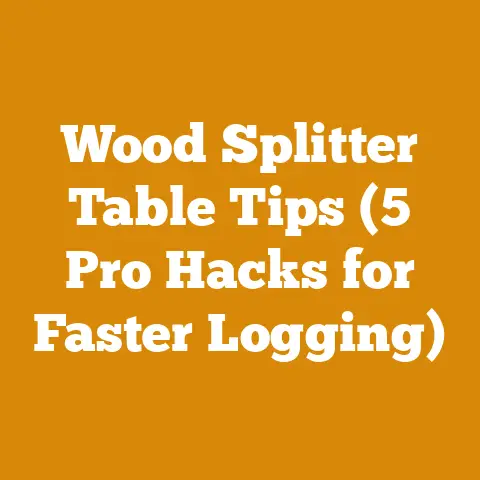How Much Are Walnut Logs Worth? (5 Insider Wood Pricing Tips)
How Much Are Walnut Logs Worth? (5 Insider Wood Pricing Tips)
Have you ever looked at a majestic walnut tree and wondered, “What’s that worth in timber?” Figuring out the value of walnut logs can feel like navigating a forest without a map. The pricing is complex, influenced by factors ranging from log size and quality to market demand and even the current economic climate. Many folks, both seasoned woodworkers and landowners alike, struggle to get a fair price for their walnut. That’s where this guide comes in. I’m going to share five insider tips to help you understand walnut log pricing, so you can make informed decisions, whether you’re buying or selling.
The Walnut Enigma: Why Pricing Is So Tricky
Before diving into the tips, let’s address the elephant in the woodlot: why is walnut pricing so complicated? Unlike some commodity woods, walnut’s value isn’t solely determined by volume. It’s a specialty hardwood, prized for its rich color, beautiful grain patterns, and workability. This means that imperfections, size, and even the tree’s history can drastically affect its worth. It’s not just about board feet; it’s about the potential yield of high-quality lumber.
My Experience with Walnut’s Volatility:
I remember helping a friend clear some land on his property a few years back. He had a couple of decent-sized walnut trees, and we figured we’d make some good money selling them. We contacted a local sawmill, and the initial estimate was promising. However, after the logs were inspected, the price dropped significantly due to some hidden metal inclusions (likely from old fencing). It was a hard lesson learned about the importance of thorough inspection and understanding the grading process.
Tip #1: Understand Walnut Grading – The Key to Unlocking Value
Walnut grading is the foundation of pricing. It’s how buyers assess the quality and potential yield of a log. Different grading systems exist, but the most common one used in the US is based on standards set by the National Hardwood Lumber Association (NHLA). However, for walnut specifically, some regional variations and buyer-specific grading systems are common.
Key Grading Factors:
- Diameter: Larger diameter logs generally command higher prices. This is because they yield wider boards, which are more desirable.
- Length: Longer logs are also preferred, as they allow for longer, continuous grain patterns in finished pieces.
- Defects: Knots, cracks, rot, metal inclusions, and other imperfections significantly reduce the grade and value of a log. The fewer defects, the better.
- Color and Figure: Rich, consistent color and interesting grain patterns (like curl or crotch figure) can drastically increase the value of a log.
- Straightness: Straight logs are easier to process and yield more usable lumber.
NHLA Grades (Simplified for Walnut):
- FAS (First and Seconds): The highest grade, yielding a high percentage of clear, wide cuttings. This is what you’re aiming for.
- F1F (First and Seconds, One Face): Similar to FAS, but allows for slightly more defects on one face of the board.
- Selects: A lower grade than FAS, with smaller minimum cutting sizes.
- Common Grades (1 Common, 2 Common, etc.): These are lower grades, suitable for more rustic applications or smaller projects.
Data Point: According to a 2023 report by the Illinois Department of Natural Resources, FAS grade walnut logs can fetch prices 2-3 times higher than 1 Common grade logs. This highlights the dramatic impact of grading on value.
Actionable Tip: Before contacting buyers, thoroughly inspect your logs. Look for any visible defects and try to estimate the percentage of clear cuttings you think the log will yield. This will give you a better understanding of its potential grade and value.
Tip #2: Master the Art of Board Foot Calculation
Board feet are the standard unit of measurement for lumber and logs. Knowing how to calculate board feet is crucial for understanding pricing. One board foot is defined as a piece of wood 1 inch thick, 12 inches wide, and 12 inches long.
Scribner Log Scale: The most commonly used log scale in the Eastern United States is the Scribner Decimal C Scale. It estimates the number of board feet that can be sawn from a log based on its diameter and length.
Doyle Log Scale: Another common scale, particularly in the Southern United States. The Doyle scale tends to underestimate the yield of smaller logs and overestimate the yield of larger logs compared to the Scribner scale.
International Log Scale: Considered the most accurate scale, but less commonly used in practice due to its complexity.
The Scribner Formula (Simplified):
While sawmills often use Scribner Log Scale tables, you can approximate the board foot volume using the following formula:
(Diameter in inches – 4)² x (Length in feet / 16) = Approximate Board Feet
Example:
A log with a diameter of 16 inches and a length of 12 feet:
(16 – 4)² x (12 / 16) = 144 x 0.75 = 108 Board Feet (Approximate Scribner)
Important Considerations:
- Log scales are estimates. Actual yield can vary depending on the sawing method and the skill of the sawyer.
- Different log scales will give you different results. Be sure to clarify which scale the buyer is using.
- Taper: Logs naturally taper from base to top. Use the average diameter (measured at both ends and averaged) for more accurate calculations.
Data Point: A study by Purdue University found that the actual lumber yield from walnut logs can vary by as much as 20% from the Scribner scale estimate, depending on the sawing technique used.
Actionable Tip: Use an online board foot calculator or a log scale table to estimate the volume of your logs. Be aware of the log scale being used in your region and by potential buyers.
Tip #3: Research Local Market Demand and Pricing Trends
Walnut pricing isn’t static. It fluctuates based on market demand, economic conditions, and regional factors. Understanding these trends can give you a significant advantage in negotiating a fair price.
Factors Influencing Walnut Prices:
- Economic Conditions: During economic booms, demand for high-end furniture and woodworking projects increases, driving up walnut prices. Recessions can have the opposite effect.
- Furniture Trends: The popularity of walnut in furniture design can impact demand. If walnut is “in,” prices tend to rise.
- Export Markets: A significant portion of high-grade walnut is exported to Asia and Europe. Changes in international demand can affect prices.
- Regional Differences: Prices can vary depending on your geographic location. Areas with a strong woodworking industry or a high concentration of walnut trees may have different pricing dynamics.
- Seasonality: Logging and milling activity tend to be seasonal, which can affect supply and demand.
Finding Pricing Information:
- Contact Local Sawmills: Call several local sawmills and ask about their current prices for walnut logs. This will give you a sense of the going rate in your area.
- Check Online Marketplaces: Websites like Craigslist or Facebook Marketplace can provide some insight into local pricing, but be cautious as these prices may not always be accurate or representative of commercial sales.
- Consult with a Forestry Professional: A consulting forester can provide expert advice on timber valuation and market trends in your region.
- Government Resources: Some state forestry agencies publish timber price reports. Check your state’s Department of Natural Resources website.
Data Point: According to the USDA Forest Service, the average stumpage price (the price paid to the landowner for standing timber) for black walnut in the Central States region has fluctuated by as much as 30% year-over-year in recent years, highlighting the volatility of the market.
Actionable Tip: Conduct thorough research on local market conditions before selling your walnut logs. Contact multiple buyers and compare their offers. Don’t be afraid to negotiate.
Tip #4: Understand the Costs Involved in Harvesting and Transportation
The price you receive for your walnut logs isn’t just about the value of the wood itself. It’s also influenced by the costs associated with harvesting, processing, and transporting the logs to the sawmill. Understanding these costs can help you negotiate a better price and avoid unpleasant surprises.
Cost Components:
- Harvesting Costs: This includes the cost of felling the trees, limbing, bucking (cutting into logs), and skidding (dragging the logs to a landing area).
- Labor: If you’re hiring a logging crew, labor costs can be a significant expense. Logging labor can range from $25 to $50+ per hour depending on experience and location.
- Equipment: Chainsaws, skidders, and other logging equipment require maintenance and fuel. Chainsaw costs can range from $300-$1500 depending on size and brand. Fuel costs can easily add up to $50-$100 per day for a small logging operation.
- Permits: In some areas, you may need permits to harvest timber. These can range from a few dollars to hundreds of dollars depending on the regulations.
- Transportation Costs: This includes the cost of loading the logs onto a truck and hauling them to the sawmill.
- Trucking: Trucking costs are typically based on distance and weight. Expect to pay $3-$5 per mile for a typical log truck.
- Milling Costs: While you’re typically selling logs, understanding what the mill incurs is helpful.
- Sawing Fees: Sawmills typically charge a per-board-foot sawing fee. This can range from $0.50 to $1.50 per board foot, depending on the mill and the complexity of the job.
- Kiln Drying: If you want to sell kiln-dried lumber instead of logs, you’ll need to factor in the cost of kiln drying. Kiln drying costs can range from $0.50 to $1.00 per board foot.
Cost Optimization Strategies:
- DIY Harvesting (If Possible): If you have the skills and equipment, harvesting the trees yourself can save you money on labor costs. However, be sure to prioritize safety and follow all applicable regulations.
- Negotiate Trucking Rates: Get quotes from multiple trucking companies and negotiate the best possible rate.
- Sell Logs at the Landing: If possible, arrange for the sawmill to pick up the logs at the landing area. This can save you on transportation costs.
Data Point: According to a study by the University of Kentucky, the average cost of harvesting timber in the state is $150-$300 per thousand board feet. Transportation costs can add an additional $50-$150 per thousand board feet, depending on the distance to the mill.
Actionable Tip: Carefully estimate all the costs involved in harvesting and transporting your walnut logs. Factor these costs into your pricing strategy.
Tip #5: Consider Value-Added Options
Instead of selling your walnut logs “as is,” consider adding value to them to increase their worth. This could involve sawing the logs into lumber, kiln drying the lumber, or even crafting finished products.
Value-Added Options:
- Selling Lumber: Instead of selling logs, you could have them sawn into lumber. While there’s the added cost of milling, the lumber is generally worth more per board foot than logs. You can then sell the lumber to woodworkers, furniture makers, or even retailers.
- Kiln Drying: Kiln-dried lumber is more stable and easier to work with than green lumber. Kiln-drying your lumber can significantly increase its value.
- Crafting Finished Products: If you have woodworking skills, you could craft finished products from your walnut lumber. This could include furniture, cutting boards, bowls, or other items. Selling finished products can generate the highest return on your investment.
Challenges and Considerations:
- Equipment Investment: Value-added options may require an investment in equipment, such as a sawmill, kiln, or woodworking tools.
- Time and Labor: Processing logs into lumber or crafting finished products requires time and labor.
- Marketing and Sales: You’ll need to market and sell your lumber or finished products.
Case Study: From Log to Legacy:
I know a woodworker in North Carolina who started with a single walnut tree on his property. He invested in a small portable sawmill and began sawing the logs into lumber. He then built custom furniture and sold it at local craft fairs and online. Over time, he built a thriving business and now sources walnut logs from other landowners in the area.
Data Point: According to a report by the Small Business Administration, value-added wood product businesses have a higher profit margin than businesses that simply sell raw materials.
Actionable Tip: Explore value-added options to increase the return on your walnut logs. Consider the costs and challenges involved, and choose the option that best suits your skills and resources.
Final Thoughts: The Art of Walnut Valuation
Determining the worth of walnut logs is a complex process, but with a solid understanding of grading, board foot calculation, market trends, costs, and value-added options, you can confidently navigate the market and secure a fair price. Remember, knowledge is power. The more you know about the factors that influence walnut pricing, the better equipped you’ll be to make informed decisions. So, go forth, explore the world of walnut, and unlock the hidden value within those beautiful logs!






